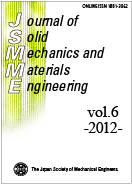All issues
Volume 6, Issue 11
Displaying 1-3 of 3 articles from this issue
- |<
- <
- 1
- >
- >|
Papers
-
Mariko MIYAZAKI, Yoshiharu KANEGAE, Tomio IWASAKI2012Volume 6Issue 11 Pages 1002-1012
Published: 2012
Released on J-STAGE: November 30, 2012
JOURNAL FREE ACCESSNanotechnology devices with strong adhesion strength are required due to the miniaturization and reduction of the thickness of electronic equipment. In this paper, a technique for using a molecular dynamics simulation to analyze the adhesion of the interface between adhesive and polyimide, that is the resin/resin interface, has been proposed. It is difficult to make the resin/resin interface when we perform a simulation because the structure of resin is complicated and the resin doesn't have a regular configuration. We made it possible to performed adhesion analysis of resin/resin interface by establishing a method for modeling the interface. We calculated the adhesion energy at the interface between three candidate adhesives (polyamide-imide, phenoxy resin, polymethyl methacrylate) and polyimide in order to evaluate the adhesion strength at the interface. The adhesion energy obtained from the molecular dynamic simulation increased in the order of polyamide-imide/polyimide > phenoxy resin/polyimide > polymethyl methacrylate/polyimide. This order agrees with the experimental result. We also showed that the adhesive with high adhesion strength had more atomic pairs in which the distance between an adhesive carbon atom and a polyimide carbon atom was less than 5 Å and interacted with the polyimide more. Our simulation method is effective for selecting the best material with the highest adhesion strength.View full abstractDownload PDF (1476K) -
Vu Le HUY, Shoji KAMIYA, Joao GASPAR, Oliver PAUL2012Volume 6Issue 11 Pages 1013-1029
Published: 2012
Released on J-STAGE: November 30, 2012
JOURNAL FREE ACCESSThis paper presents an evaluation of strength distribution and fatigue behavior of polycrystalline silicon thin film specimens patterned by etching into arbitrary shapes. The static strength distribution of specimens is described by a two-parameter Weibull distribution applied to local points along the etched surface. The fatigue lifetime is formulated also locally as a crack extension process, starting from initial cracks which represent the etching damage and thus determine the strength distribution, by applying the well-known Paris law. The parameters in the Weibull distribution and in Paris' law were fit to the results of tensile static strength and fatigue tests performed on the specimens with three different shapes fabricated under the same conditions. Parameter distribution ranges were analyzed using inferential statistics. It was found that the fracture and fatigue behaviors of the specimens can be described by using a unique set of parameters despite the different stress distribution. This means that the local characteristics of etching damage and subsequent damage accumulation under fatigue loading was independent of the shapes and thus of the stress distributions of specimens.View full abstractDownload PDF (2868K) -
Yuta MIYAZAWA, Yuichi OTSUKA, Yoshiharu MUTOH, Kohsoku NAGATA2012Volume 6Issue 11 Pages 1030-1041
Published: 2012
Released on J-STAGE: November 30, 2012
JOURNAL FREE ACCESSFatigue crack growth behavior of the epoxy resin reinforced by silica particles was investigated at various temperatures below glass-transition temperature. Kmax versus da/dt crack growth curves showed the temperature dependence, where the crack growth resistance decreased with increasing temperature. On the other hand, ΔJ versus da/dt crack growth curves showed two separated bands: one band corresponded to room temperature (22°C) and the other corresponded to elevated temperatures (50, 80°C). The hysteresis loops showed a clear nonlinear deformation behavior at elevated temperatures, while linear deformation behavior was found at room temperature. Fracture surface observations revealed two different crack growth mechanisms at each temperature. The crack propagated along the micro-cracks nucleated in the interface or in the matrix near the interface between matrix and fine particle and also propagated through pre-existing flaws in the coarse particles at room temperature. On the other hand, the crack propagated along the micro-cracks nucleated by debonding or pulling-out of fine particles and also propagated along the interface between matrix and coarse particle even if a pre-existing flaw would be in the particle at elevated temperatures. Nonlinear deformation behavior at elevated temperature would be attributed not only to matrix softening but also to debonding of particles.View full abstractDownload PDF (1198K)
- |<
- <
- 1
- >
- >|
